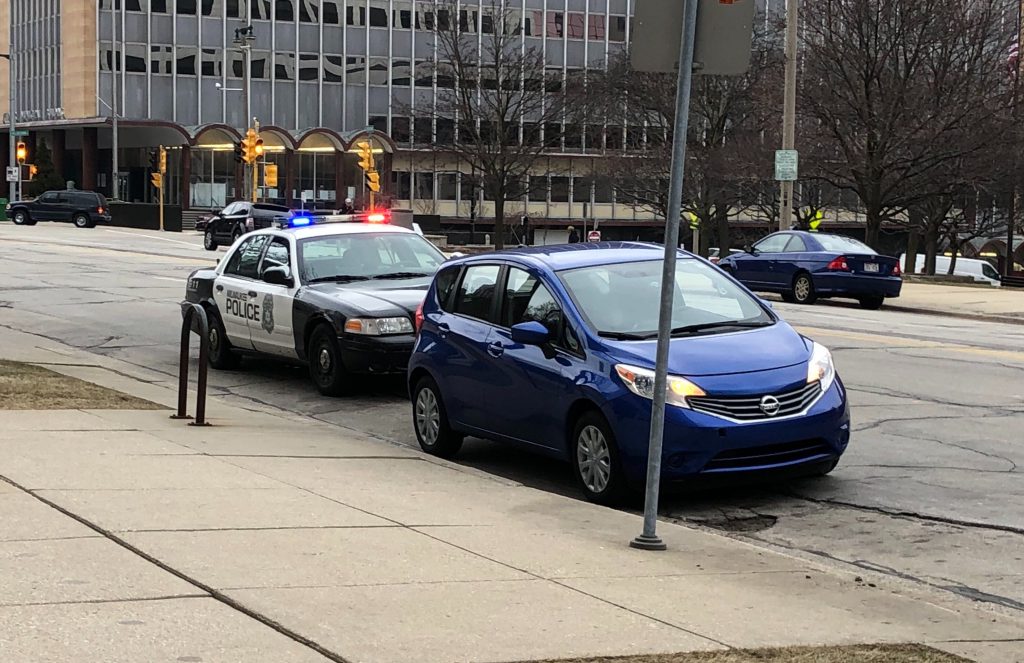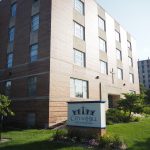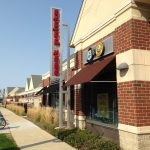Will “Safer at Home” Be Policed Fairly?
Some areas most impacted by COVID-19 have also been victims of excessive policing.
COVID-19 has opened a Pandora’s box of unprecedented actions, challenges and systemic strains. Anxieties as states implemented shelter in place orders were amplified in some areas by concerns about the punitive consequences for violating the edicts. In Wisconsin, residents may face a $250 dollar fine and up to 30 days in jail for violating the state’s Safer at Home order.
Gov. Tony Evers chose the soft-sounding name “safer at home” after reassuring citizens that a lockdown scenario wasn’t on the horizon. Rep. LaKeshia Myers (D-Milwaukee) says she understands the governor’s reasoning, at the very least, was to avoid scaring people. “However,” Myers told Wisconsin Examiner, “I think that when you use those terms [shelter in place, lockdown], people understand what that means. That means no unnecessary movement.”
As the days and weeks passed neighbors took to social media to criticize people they’d seen out and about in their neighborhoods, whether it was the number of visitors to county parks, or people walking Milwaukee’s lakefront or teenagers passing time at local basketball courts.
Milwaukee Ald. Russell Stamper (Dist. 15), who represents part of the predominately African-American North Side, said he’d noticed many people out in his area. Feeling that people were “either unaware” of the order or “not taking this as serious as it is,” Stamper noted that he supports enforcement of the order. Several Milwaukee Police Department (MPD) supervisors have reached out to him, he said, with concerns about crowds observed by officers on in North Side neighborhoods.
The locale is a powder keg for the pandemic for several reasons. The area’s largely African American neighborhoods have historically been victimized by excessive policing and lack of resources allocated by the city, county and state. In 2018, MPD was the subject of a stop and frisk lawsuit spearheaded by the American Civil Liberties Union (ACLU). The city ultimately settled the lawsuit which, among other things, found that 80% of stop and frisk incidents lacked documented justification. Now, as COVID-19 spreads, the North Side finds itself at the epicenter of cases statewide.
“A crisis like COVID-19 is bound to exacerbate existing racial-ethnic and socio-economic disparities. Not only within the healthcare system, and in terms of health outcomes, but also within the criminal justice system,” Dr. Shannon Monnat, chair of the Lerner Center for Public Health Promotion at Syracuse University, told Wisconsin Examiner. “So in a very racialized society like ours where people of color and poor people are disproportionately arrested and incarcerated, it wouldn’t come as a surprise at all if shelter in place policies had a disproportionately negative impact on African Americans and on poor residents.”
In many ways, the pandemic is spotlighting racial and economic disparities across America, from who has access to quality healthcare, to who had to wait the longest and was most at risk during the April primary election. People in low-income communities may be both vulnerable to the virus itself, and targeted for stricter enforcement of social distancing measures.
Alan Schultz, an anti-mass-incarceration activist, feels that using a punitive model for shelter in place orders will perpetuate a pattern of fines and possible incarceration which keeps people in a poverty cycle.
Officers, however, don’t need to rely solely on punishment. Maria Haberfeld, a professor of police science at John Jay College and expert in police training and ethics, has been involved in planning and coordinating with department leaders in several states to determine the best practices for shelter-in-place enforcement.
“For example in New York, most of the time police officers are in cars and are using their radios and microphones trying to disperse individuals who are kind of hanging around,” says Haberfeld. While many of those groups of people hanging around are young people, who experience even such warnings as a negative encounter with police, Haberfeld says she has seen police disperse a family gathering in one her own affluent community.
Although Haberfeld explains that, “it’s done basically differently by each police department based on the directives and the roll-call suggestions on any given day.” Pandemic or not, police have a variety of duties they still must perform, and crimes which they must respond to and investigate, which has become more challenging during the COVID-19 pandemic.
“As much as enforcement of this [shelter in place] is considered to be important,” Haberfeld says it’s “more important” to keep up enforcement of other laws as well. “It will really depend on the number of officers who are available,” she explains. “As much as the governor, the mayor, might say, ‘go enforce this,’ I think that the focus will be on felonies and progress rather than going out there and trying to write some tickets for people who are violating the stay-at-home order.”
Several Wisconsin police agencies have said they’re taking an “education” approach to the Safer at Home order. Broadly speaking, departments including the State Patrol, Milwaukee Police Department and others, have said they’re not interested in conducting traffic stops to see if travel is essential.
Milwaukee Mayor Tom Barrett and out-going County Executive Chris Abele have said they’d prefer enforcement to be minimal, but warn that if people don’t follow the public safety order then police will step up the game.
According to Wisconsin Public Radio, 10 people are facing charges in Fond du Lac County for violating the order. Green Bay officers also handcuffed a juvenile and took him home after disobeying the order. MPD has also released a video warning that officers are increasingly putting their attention towards Safer at Home violators.
Nevertheless, the possibility of abuse remains. “Of course, there’s the fact that African Americans are much more likely to be stopped by police than other groups to begin with,” explains Monnat. “So, even if there were, say, equal rates of blacks and whites who were not abiding by the shelter-in-place orders, everything we know about the history of the criminal justice system and racially disparate policing policies suggests that police would be more likely to stop and ticket black residents.”
Monnat also notes that black, brown and poor residents are more likely to be employed in jobs which are now deemed “essential.” More time out and about means more opportunities to encounter an officer, even if the stop begins with a broken tail light, or other minor infraction. “There’s also a reality that this particular demographic has families that rely on them more, support networks that rely on them more,” explains Monnat. “They might have other people that they have to take care of, and as a result have to go out into the public more for that than, say, more middle-class white people.”
As Haberfeld pointed out, different departments may have different attitudes. In Wisconsin, whereas the state set the punitive consequences of the Safer at Home order at a $250 fine, the city of Wauwatosa, a suburban Milwaukee community, doubled its fine to $500. Wauwatosa immediately borders some of the hardest hit North Side neighborhoods for COVID-19. Its police department has also been at the center of several controversies involving racially biased policing spanning decades.
Myers says that these subtle differences in how surrounding Milwaukee communities are conducting the Safer at Home order is on her radar. She wants to make sure various police chiefs and sheriffs are on the same page when it comes to enforcement. “I think there’s a big difference between a fine being $250 in Milwaukee, and it being doubled in Wauwatosa,” says Myers, who represents both areas. “I have people who literally, if they walk across the street, they are in Wauwatosa.”
Myers sees an uneven approach to policing during the pandemic. “There were a lot of people who do not live on the North Side that were down by the lakefront,” she says. “And there was no enforcement at all going down to the lakefront, our lakefront has not been closed by the city — by the mayor.”
In one of America’s most segregated cities, “we have to look at how our community is laid out, and what the ramifications are,” Myers says. A crucial first step, which she feels should have been taken right away at the state level, was getting law enforcement and local municipalities on the same page, “so that everybody will not be kind of making their own judgment calls.”
Reprinted with permission of Wisconsin Examiner.
More about the Coronavirus Pandemic
- Governors Tony Evers, JB Pritzker, Tim Walz, and Gretchen Whitmer Issue a Joint Statement Concerning Reports that Donald Trump Gave Russian Dictator Putin American COVID-19 Supplies - Gov. Tony Evers - Oct 11th, 2024
- MHD Release: Milwaukee Health Department Launches COVID-19 Wastewater Testing Dashboard - City of Milwaukee Health Department - Jan 23rd, 2024
- Milwaukee County Announces New Policies Related to COVID-19 Pandemic - David Crowley - May 9th, 2023
- DHS Details End of Emergency COVID-19 Response - Wisconsin Department of Health Services - Apr 26th, 2023
- Milwaukee Health Department Announces Upcoming Changes to COVID-19 Services - City of Milwaukee Health Department - Mar 17th, 2023
- Fitzgerald Applauds Passage of COVID-19 Origin Act - U.S. Rep. Scott Fitzgerald - Mar 10th, 2023
- DHS Expands Free COVID-19 Testing Program - Wisconsin Department of Health Services - Feb 10th, 2023
- MKE County: COVID-19 Hospitalizations Rising - Graham Kilmer - Jan 16th, 2023
- Not Enough Getting Bivalent Booster Shots, State Health Officials Warn - Gaby Vinick - Dec 26th, 2022
- Nearly All Wisconsinites Age 6 Months and Older Now Eligible for Updated COVID-19 Vaccine - Wisconsin Department of Health Services - Dec 15th, 2022
Read more about Coronavirus Pandemic here




















